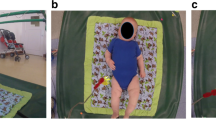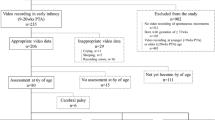Abstract
The aim of this study was to assess the effect of an infant’s favoured position on their motor development at the age of six months. Seventy-five full-term infants were prospectively observed at home for their preferred sleep, awake, play and uninterrupted positions. A parental log was completed daily and then weekly up to the age of six months, when the Alberta Infant Motor Scale (AIMS) was administered. No significant relationship between the preferred or sleep positions as well as the awake and mutual play positions and gross motor developmental attainment at six months of age was noted. A significant change in the preferred recumbent posture with increased prone positioning both during sleep and awake time over the first six months was noted. A balanced positioning policy while awake, regardless of the infant’s preference while recumbent, is not associated with gross motor delay.
Similar content being viewed by others
References
[No authors listed] (1992) American Academy of Pediatrics (AAP) Task Force on Infant Positioning and SIDS: positioning and SIDS. Pediatrics 89:1120–1126
Back to Sleep Campaign of Healthy Child Care America (2008) Back to sleep, tummy to play (pamphlet). Available online at: http://www.healthychildcare.org/pdf/SIDStummytime.pdf
Bartlett DJ, Kneale Fanning JE (2003) Relationships of equipment use and play positions to motor development at eight months corrected age of infants born preterm. Pediatr Phy Ther 15:8–15
Cohen J (1960) A coefficient of agreement for nominal scales. Educ Psychol Meas 20:37–46
Davis BE, Moon RY, Sachs HC, Ottolini MC (1998) Effects of sleep position on infant motor development. Pediatrics 102:1135–1140
Dewey C, Fleming P, Golding J; ALSPAC Study Team (1998) Does the supine sleeping position have any adverse effects on the child? II. Development in the first 18 months. Pediatrics 101(1). Available online at: http://pediatrics.aappublications.org/cgi/content/full/101/1/e5
Fleuren KM, Smit LS, Stijnen T, Hartman A (2007) New reference values for the Alberta Infant Motor Scale need to be established. Acta Paediatr 96:424–427
Jantz JW, Blosser CD, Fruechting LA (1997) A motor milestone change noted with a change in sleep position. Arch Pediatr Adolesc Med 151:565–568
Majnemer A, Barr RG (2005) Influence of supine sleep positioning on early motor milestone acquisition. Dev Med Child Neurol 47:360–376
Majnemer A, Barr RG (2006) Association between sleep position and early motor development. J Pediatr 149:623–629
Monson RM, Deitz J, Kartin D (2003) The relationship between awake positioning and motor performance among infants who slept supine. Pediatr Phys Ther 15:196–203
Pin T, Eldridge B, Galea MP (2007) A review of the effects of sleep position, play position, and equipment use on motor development in infants. Dev Med Child Neurol 49:858–867
Piper MC, Darrah J (1994) Motor assessment of the developing infant. WB Saunders, Philadelphia, PA
Piper MC, Darrah J (1995) Response to Dr. Costers’ critique of the Alberta Infant Motor Scale (AIMS). Phys Occup Ther Pediatr 15:65–69
Salls JS, Silverman LN, Gatty CM (2002) The relationship of infant sleep and play positioning to motor milestone achievement. Am J Occup Ther 56:577–580
Willinger M, Hoffman HJ, Wu KT, Hou JR, Kessler RC, Ward SL, Keens TG, Corwin MJ (1998) Factors associated with the transition to nonprone sleep positions of infants in the United States: the National Infant Sleep Position Study. JAMA 280:329–335
Acknowledgement
We are indebted to the families who participated in the study, to Prof. M. Jaffe for his advice and to Mrs. R. Abiry for her help in the preparation of the manuscript.
Author information
Authors and Affiliations
Corresponding author
Rights and permissions
About this article
Cite this article
Carmeli, E., Marmur, R., Cohen, A. et al. Preferred sleep position and gross motor achievement in early infancy. Eur J Pediatr 168, 711–715 (2009). https://doi.org/10.1007/s00431-008-0829-4
Received:
Accepted:
Published:
Issue Date:
DOI: https://doi.org/10.1007/s00431-008-0829-4




